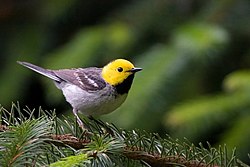Description
Hermit warblers are dark gray in coloration on top, and white below, and their flanks are streaked with black. The wings have two diagonal white wing bars. The majority of the hermit warbler's head is yellow, and males have a dark black throat, while females have much less black on their throat bib and immature birds have no black throat. Both males and females measure 5.5 inches (14 cm) in length, 0.3 to 0.5 oz (8.5 to 14.2 g) in weight, and 7.9 in (20 cm) in wingspan. [2]
Habitat
Hermit warblers are common, but incredibly shy, birds that dwell in open coniferous forests. They are also found in wetter habitats for nesting, and in various mountain habitats. [3] Their summer breeding range is the majority of the west coast of the United States up to Washington. They will sometimes winter in south-west California, but they are migratory and will winter in Central America as far south as Panama. Other nesting habits are mostly unknown. During migration they can be found in both coniferous and deciduous habitats as well as water lined wooded areas, desert oases, and in suburban areas. You can usually find these birds in Tall Coniferous forest, Douglas fir, Pine, Redwood, and in the mountain like areas. [2] [3] [4]
Effects of climate change
The range of the hermit warbler is expected to change as the climate warms, the breeding range expected to expand north and east but lose much of the current range in Northern California as well as some range in parts of Oregon, Washington, and Canada. [3] Extreme warming will put them at risk of heat waves as well as flooding during the nesting season. [3]
This page is based on this
Wikipedia article Text is available under the
CC BY-SA 4.0 license; additional terms may apply.
Images, videos and audio are available under their respective licenses.


